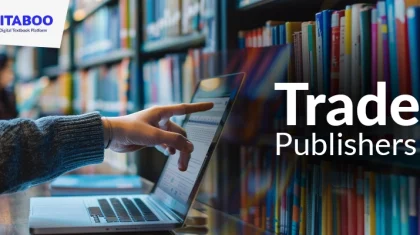
5 Best Digital Platforms that Enhance Standards-Based Learning in K12 Education
Summarize this blog with your favorite AI:
Technology and advanced software have been the way to go for inclusive learning and adherence to learning standards. Standards-based learning for K12 classrooms is increasingly implemented to ensure that students meet academic expectations by mastering competencies.
Digital textbook platforms like KITABOO provide versatility, personalization, and support so every student moves toward these learning outcomes. This makes it easier for teachers to monitor, modify, and customize instruction. Effective digital platforms in K12 scenarios should establish the foundation for an adaptive, standards-driven learning environment.
Let us delve into how digital platforms encourage standards-based learning in K12 classrooms and learn about the top 5 platforms that offer the best support!
Table of Contents:
I. What is Standards-Based Learning in K12?
II. Importance of Digital Media Platforms for Standards-Based Learning
- Personalized Learning at Scale
- Data-Informed Insights and Progress Monitoring
- Alignment with Future Educational Trends
III. Key Parameters in Selecting a Digital Tools for Standards-Based Learning in K12
IV. Top 5 Digital Software for Personalized Standards-Based Learning in K12
V. Conclusion
What is Standards-Based Learning in K12?
Standards-based learning empowers students to enhance learning by acquiring the full skills and knowledge in every grade level. This learning emphasizes student evaluations of certain competencies with a focus on rubrics or tracking progress.
For example, in a language arts class, standards-based teaching might include focused standards such as “Analyze the main idea and supporting details in informational texts.”
Rather than getting a grade on an entire assignment, students are assessed on their ability to understand this one skill. This helps educators and students identify where they are strong and where they may need some work.
Importance of Digital Media Platforms for Standards-Based Learning
A report states that in the 2022-2023 school term, the average number of digital tools each K12 school district in the United States accessed had risen to over 2,591.
Another survey reported that 90% of K12 teachers in public schools in the United States believe that digital learning tools are effective for conducting research or searching for information.
Here is how educational publishers offer support and enhancement of standards-based learning in K12 learning:
1. Personalized Learning at Scale
Students must demonstrate individual mastery of certain standards, and adaptive and personalized experiences become the core of digital textbook platforms.
Publishers can generate content that changes according to the learners’ learning levels and offer specific interventions so that all children reach competency levels irrespective of their starting points.
For example, KITABOO, a cloud-based digital textbook platform, uses AI to provide instant student performance analysis with personalized pathways.
2. Data-Informed Insights and Progress Monitoring
Digital platforms give instructors the power of precise analytics and reporting so they might track student progress toward any standard. Those findings allow teachers to find exactly where the students require remediation and adapt instructional strategies according to that remediation, measure mastery with precision, and track student progress.
3. Alignment with Future Educational Trends
We now need rapid adoption of digital learning, as the worldwide e-learning marketplace is expected to post a compound annual growth rate of 9.1% between now and 2026. For K12 publishers, the adoption of digital platforms will be a forward step in aligning with trends that can change the face of available resources.
Key Parameters in Selecting an Appropriate Digital Platform for Standards-Based Learning in K12
Here are some key considerations to ensure that K12 publishers and schools pick up an appropriate digital platform:
1. Alignment with Standards and Flexibility
The chosen platform should ensure easy alignment with state or national standards. For teachers, it should offer assignments, assessments, and learning resources that can be directly connected to specific standards. For publishers, a pre-built-in platform should have standard-alignment capabilities that reduce manual alignment and maintain the standard levels of learning materials.
2. Ease of Use and Accessibility
A platform should be easy to use and offer a good user experience. Other features will include accessibility features, such as compatibility with screen readers, closed captioning, and multilingual options for a range of diverse learners, including people with disabilities or language learners.
3. Engagement Features
Interactivity through quizzes, videos, gamified learning modules, and tools that help encourage collaboration facilitates higher levels of student engagement and retention. Publishers need to find platforms that can support multimedia while also providing an immersive, standards-based environment.
Top 5 Digital Software for Personalized Standards-Based Learning in K12
Here are the five leading digital platforms for standards-based learning, each with unique features and benefits for K12 environments:
1. KITABOO
KITABOO is a digital publishing and eLearning platform with interactive content that supports standards-based learning. It empowers K12 educators to customize digital content based on educational standards, and it is a versatile tool for developing eBooks, interactive lessons, and assessments meant to boost student engagement and mastery.
Features
- KITABOO empowers the instructor to develop rich interactive eBooks containing videos, animations, and quizzes related to curriculum standards.
- KITABOO, the leading digital textbook platform, has inherent analytics that allow teachers to check whether students have read or understood the material.
Advantages
- KITABOO’s content creation and tracking tools support personalized and standards-based instruction.
- Teachers can monitor and understand how students interact with content, hence suggesting how each student should be taught.
2. Equatio
Equatio is a digital math tool designed to enhance mathematics and science education by letting students and teachers create, edit, and explore math-related content interactively. This feature is very helpful in teaching math and science standards through standards-based learning.
Features
- Voice Recognition transcribes spoken math equations into digital text and can read out complex expressions from the computer that students can easily input.
- This is available on Google Workspace, Microsoft Word, and other resources utilized in K12.
Benefits
- Equatio interactive graphing tools allow graphing concepts to be explored deeply, which helps visualize learning.
- Equatio’s features, from voice-to-math conversion to presenting math in a wide range of ways, support a variety of learning styles and abilities.
3. SchoolMint Hero
SchoolMint Hero encourages positive behaviors in a school setting by enabling teachers and administrators to track and reinforce desirable student behavior. This comes in handy in backing social-emotional learning standards that are fast becoming part of the K12 standards-based frameworks.
Features
- The dashboard helps teachers record and analyze student behavior data.
- Incentives can be developed to act as rewards for the desirable behavior that is in line with SEL standards.
Benefits
- The software promotes standards-based SEL through a framework for practicing positive behaviors, an important part of a child’s success.
- It promotes encouraging behaviors consistent with K12 learning objectives and guiding a positive school climate.
4. IXL
IXL is an online learning platform that practices various subjects, such as math, language arts, science, and social studies. The resource encompasses a large collection of standards-aligned questions and provides immense relief for reinforcing standards across grade levels and subjects.
Features
- IXL aligns every question to specific state and national standards, thus it is pretty easy for the teachers to make a perfect target for learning objectives.
- The platform identifies a student’s rate of learning and offers personalized practice and recommendations.
Benefits
- IXL diagnoses continuously so that the program adjusts the content according to K12 students.
- IXL ensures students get practice and helps improve their understanding of the standards.
5. Explain Everything
Explain Everything is an interactive whiteboard that promotes learning and collaboration by creating and sharing multimedia content. It can be applied to lessons aligned with the standards, especially those in which some sort of visual presentation.
Features
- Teachers can add lessons on the interactive whiteboard, including videos, drawings, and text, to accommodate multiple learning styles.
- Explain Everything offers real-time collaboration, so students can work on projects with each other even from far away.
Benefits
- Teachers can record lessons and explanations for their review at the discretion of students.
- Educators can use interactive multimedia lessons to better engage students with standards-based learning and help students understand the core concepts through several representations and modes of interaction.
Conclusion
Digital learning platforms are crucial to standards-based learning because they enable personalized instruction, provide data-driven insights, enhance engagement, and offer accessibility options for a diverse range of K12 learners. For K12 publishers, using digital textbook platforms like KITABOO is a strategic move toward aligning with future trends in education.
While innovations in K12 publishing allow education providers to achieve effective interactive learning, choosing the right digital platform is crucial. By focusing on alignment, usability, data analytics, engagement, scalability, and security, publishers and schools can encourage student achievement and prepare them for life-long learning.
Get help from KITABOO to make use of the best digital tools for your K12 students today.
Also check:
Digital Textbook Platform for K12 Publishers
Digital Textbook Platform for Associations & Societies
Digital Textbook Platform for Trade Publishers
Discover how a mobile-first training platform can help your organization.
KITABOO is a cloud-based platform to create, deliver & track mobile-first interactive training content.



